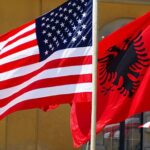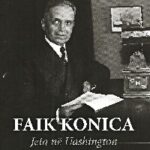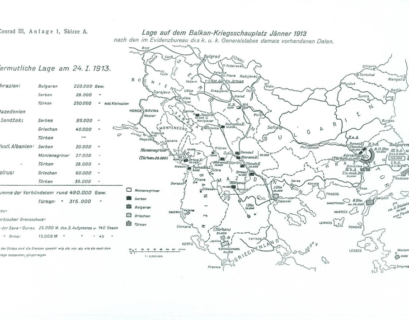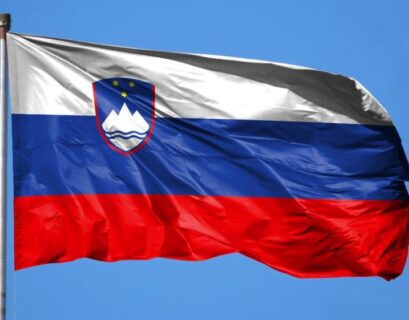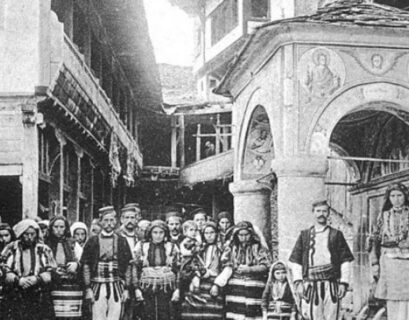By Bernd J. Fischer
Albania’s foreign relations during the 1920s and 1930s were dominated by the growing connection between Zog’s government and that of Mussolini – in part because Italy was the only state willing to make the “uneconomic” loans needed to build up Albania’s essentially medieval economy. With the loans came influence on a number of different levels, most of it unwanted. But while Italian influence was paramount, other Western states impacted Albania as well, not the least of which was the United States. While United States-Albanian relations during the 1920s and 1930s must be characterized as marginal, traces of economic, social/cultural, and political influence can be found. It is the purpose of this paper to present a brief sketch of the relationship between the United States and Albania during the Zog years, with occasional comments concerning areas where the author believes more study is needed and is possible based, in part, upon the availability of new documentation.
Of least importance in the overall Albanian-American relationship during the period in question, with the exception perhaps of immigrant remittances, was the economic connection. Despite a favored nation agreement, the volume of trade between the two countries remained quite small. Enver Hoxha in his book The Anglo- American Threat to Albania maintains that by granting the U.S. favored-nation status in the early 1920s, Zog had “given the keys to Albania” to the United States. He goes on to suggest that this disgraceful document dangerously undermined the independence of the country. If American businessmen had the keys to the kingdom, they did little to exploit the advantage. The U. S. did sell the Albanians some coffee, automobiles and accessories as well as cotton goods, but in 1931 imports from the U. S. made up less than seven percent of Albania ‘s total imports. Throughout the 1930s America’s share decreased making up only 6.4% of Albania’s imports in 1933, 5.7% in 1934, and 3.9% in 1935. Albanian exports to the United States during the same period made up primarily of nuts and cheese – counted for a slightly higher market share. In 1934 the United States absorbed 9.6% of Albania’s exports, which rose to 14.2% in 1935. The Italians dominated both the import and export market during the same period, controlling in excess of fifty percent of both.
American business saw few opportunities for investment in Albania. At the beginning of the 1920s -and indeed throughout the entire Zogist period -Albania remained impoverished and predominantly agrarian. Ninety percent of the population was either engaged in agriculture or animal husbandry, although only nine percent of the land was arable. On the little land available for farming, medieval techniques of crop rotation as well as wooden plows were still widely in use. The irrigation system in most parts of the country dated back to the Middle Ages. Industry was either nonexistent or of the handicraft variety. What little production did exist was limited to gold and silver filigree work done by skilled craftsmen, tanning and dying of saddle and shoe leather by a primitive vegetable process, and the production of rough oval form tiles and a small amount of heat-treated and sun-dried bricks. None of these products were exported and little was sold within the country. Everything that was needed in an Albanian household could be produced in the home. The weak Albanian internal market encouraged the United States Commerce Department to conclude in 1923 that there was little opportunity for the small investor in Albania.
Large investors were hardly better off, even in traditionally exploitive enterprises like the extraction of raw materia1s. In the 1920s Albania’s mineral wealth for the most part was unknown since few statistics existed and few surveys had been done. Still, during the First World War, the Austrians and the Italians discovered coal, silver, copper, asphalt, and petroleum. Once Zog came to power he sold concessions to foreign companies as a means of raising revenue and developing the country. Of primary interest to Western firms was Albania ‘s oil potential. There was quite a struggle for oil concessions between the British, the Italians and the Americans, and even to a certain extent within American oil circles between Sinclair Oil and Standard Oil. Sinclair initially had the inside track in convincing the U.S. secretary of commerce Herbert Hoover in 1922 to press the American senate on behalf of its interests. At least in part as a result, in June of 1922 Maxwell Blake, who was appointed American Consul General on temporary detail, arrived in Albania and produced a lengthy report in April 1923 published in the United States Department of Commerce Reports called “Economic Conditions in Albania” which dealt cursorily with the oil question. Standard Oil, too, managed to gain some U.S. government support and one of it officials actually arrived in Albania in 1923 on a destroyer – significantly during the parliamentary debate on the British Anglo-Persian concession. Some have interpreted this as a direct threat. Blake went on to work diligently for official American recognition of Albania and was able to secure that recognition in July 1922, remaining in Albania as American Commissioner with the rank of minister until a permanent American representative was appointed.
The Anglo-Persian contract was modified and passed in 1925 – followed by protest notes from the Italian and newly established American legations. These notes resulted in further concessions with Standard Oil being granted the right to prospect over 80,000 hectares – ultimately Standard Oil paid thirty thousand dollars for drilling rights on 51,000 hectares of land – but it actually did very little, preferring to wait to see whether any of the other companies would be able to pay for their concession investment out of oil revenues. While Enver Hoxha saw this as yet another example of Zog selling Albania off to the Americans and the British, this investment proved disastrous for the American company. By 1929 Standard Oil had abandoned its holding after paying the Albanian government the arrears due on the concession agreement.
The American oil prospectors discovered a two-fold problem. First the quality of the oil found was not good. Because of its asphalt base and high sulphur content, the oil was quite expensive to refine. The most serious problem, however, was the difficulty of extraction and shipment. Albania ‘s transportation system in the 1920s can only be described as primitive. Proper roads linking the major inland towns and the coast were basically non- existent. Although some roads had been built by the Austrians and the Italians during the First World War, they were constructed rapidly of rather poor materials for wartime purposes. Due to domestic conditions and lack of maintenance, these roads had deteriorated. On the few roads that did exist, wheeled traffic was possible only during the summer months, since they were basically mud paths that became impassible in bad weather. With few exceptions, travel was possible only on foot or by pack train. Motorized traffic was essentially non-existent. The country’s entire rolling stock in 1920 consisted of three miserable old Fords left behind by an American relief mission. Although the Austrians had constructed a narrow-gauge Decauville railroad from Durrës to Elbasan and from Tirana to Durrës, it had been completely neglected and by 1922 was no longer salvageable. Albania would not have its first functioning railroad until after the Second World War.
Some areas of the country were cut off for months at a time. Other areas were cut off completely as few bridges remained, most having been blown up during the First World War or were carried away by floods. These difficult conditions made the oil business extremely difficult if not impractical, at least in the 1920s and 1930s. The Italians carried on, but primarily for political purposes. The Italian minister F. Jacomoni mentioned to Sir Robert Ryan, the British minister, in 1939 that Italian exploitation of oil in Albania was a disaster and would always remain unremunerative. During the Second World War, as Italy’s traditional sources of oil began to dry up, Albanian oil proved useful, but continued to be very expensive. From a purely economic standpoint, then, Standard Oil’s exit from Albania was a prudent move. With this move, however, the last major economic connection between the U. S. and Albania during the interwar period was severed. All that remained was the small volume of foreign trade and immigrant remittances that tended to decline during the 1930s because the world-wide depression had produced significant unemployment in the United States.
The social-cultural connection between the United States and Albania during the Zog period initially was as limited as the economic connection but experienced some increase during the course of the 1930s. Some of this connection remained at the level of the royal family and the court. Zog himself expressed some interest in American culture, as perhaps best evidenced by his choice of the play “Uncle Tom’s Cabin” which was presented by the Philodramatic Society of Shkodër on the occasion of the elaborate celebrations surrounding his birthday in 1929. If the intent of this performance was to impress resident Westerners with his grasp of Western culture, Zog’s gesture was not a success. According to Herman Bernstein, the American minister, the play left something to be desired in terms of casting and costume design. Bernstein has left an amusing description suggesting that the performance was “altogether the most ludicrous affair imaginable and some members of the legation staff experienced difficulty in maintaining proper decorum.”
With Zog’s marriage to Geraldine Apponyi in 1938, aspects of American culture came into somewhat better focus. Geraldine, a Hungarian countess, was born to an American mother whose influence seems to have been substantial. With Geraldine’s arrival, the connection between the court and the American mission became stronger, as evidenced by the decision to seek the protection of the American mission for Geraldine and her newborn son during the Italian invasion in 1939. Although the American minister, Hugh Grant, readily agreed, Geraldine recovered sufficiently from childbirth to flee the country with her husband. The royal sisters had made a connection with the United States during 1938 when they staged a flamboyant and according to Edith Durham a somewhat extravagant exploratory visit to the United States. While in exile Zog further extended his connection with the United States by traveling to New York and even purchasing an estate on Long Island with the intent of settling there. But declining health, along with political developments in Egypt, where Zog had moved his family and entourage after the war, ultimately prevented the move.
Some cultural connection between the United States and the educated elite – or soon to be educated elite – was provided by American missionaries like Phineas Kennedy and educators like Harry Fultz. Enver Hoxha maintains that these people were American agents whom Zog allowed into Albania as part of his desire to sell the country to foreigners. Fultz did work with the American Office of Strategic Services (O.S.S.) during the Second World War, but during the 1930s his role in Albania seemed to be purely educational. Indeed, Americans founded numerous schools, the two most important being the American School for Girls in Korçë founded in 1891 by Kennedy a Protestant missionary, and Fultz’s American Vocational Technical School in Tirana founded in 1921 and funded in part by the American Junior Red Cross between 1921 and 1933. The school provided its students with classroom instruction as well as with practical experience in such diverse fields as commercial printing, electric power generation, and farming. The school undertook numerous construction projects including building the American legation offices in Tirana.
In addition to the above, there was also a school for girls in Kamez, run by the Albanian-American Kristo Dako, who later wrote a rather sycophantic short biography of Zog, and the Albanian-American school for Agriculture in Kavajë organized by the Reverend Charles Telford Erickson. The latter was taken over by the U.S. Near East Foundation in 1930. Finally there was also a medical research institute concerned principally with malaria operated by the Rockefeller foundation and run by Dr. Lewis Hackett with stations in Tirana, Durrës, Elbasan and Vlorë. While these institutions had some influence, those connected with them were viewed with considerable suspicion following the Second World War.
The social/cultural connection experienced by the average Albanian was limited, for the most part, to friends or family who had emigrated to the United States and sent back letters, returned for periodic visits or returned to Albania to retire, and to those who had some contact with the few Americans in Albania. Independence brought quite a few Albanians back from America – indeed between 1919 and 1925 the number was likely between twenty and thirty thousand. The impact of this type of connection is difficult to quantity – and is one of those topics that deserves much more work – not only in terms of the memory of those who returned but also the impression of the U.S. and the West – the myth of the West which this type of connection inspired. Fatos Lubonja and others have worked on this question – it certainly would to interesting to discover what part of this was specifically American.
Finally, there was the political connection. As noted above, the United States recognized the independent Albania in July 1922 – in part as a result of the offer of commercial advantages and oil by the then Albanian government. To replace Maxwell Blake, its temporary representative, the United States duly sent Ulysses Grant-Smith as its first minister. But Albania was perhaps first introduced to aspects of American political culture by Fan Noli who constructed Albania’s first democratic-like government in 1924, between the regimes of Zog. Noli was educated at Harvard and spent a good deal of his life in Boston. He hoped to graft a Western-style reform movement onto Albania’s clannish, Ottoman heritage. Noli’s efforts, though certainly noble enough, failed, in part because his hesitancy with regard to elections caused the United States and others to refuse to recognize his regime, and in part because of other mistakes. Years later he admitted that he had raised unrealistic hopes about political and economic (principally land) reform and then was naturally unable to introduce effective programs to make these reforms a reality, alienating the conservative landowning classes by broaching the subject in the first place, and alienating the peasants for raising unfulfilled and perhaps even unrealistic expectations. After a scant six months in office, Noli’s coalition government was overthrown by Zog, supported by Yugoslav and White-Russian troops, financed in part with British oil money. Zog proceeded to construct an authoritarian regime similar to the governmental structures of other Balkan states. While American democratic principles disappeared, Zog’s government was arguably more appropriate for Albanian conditions at the time.
During his fourteen-year tenure as prime minister, president and finally King of the Albanians, Zog’s political relationship with the United States was at least partially regulated by three American ministers. They were responsible for the usual diplomatic treaties signed between sovereign states including a Treaty on Arbitration and Conciliation in 1928, a Naturalization Treaty in 1932, an Extradition Treaty in 1933 and a Nationality Convention in 1937. But their dispatches were occasionally trivial. At other times when reporting on an issue of some significance, their dispatches seemed to mirror the description and analysis of that of the British minister. Unlike the Americans, the British with their extensive imperial/colonial experience had many people, like Andrew Ryan their last minister during the Zog period, who were well prepared, well informed and as a result much more involved. As is often the case even today, the American diplomatic corps was burdened with political appointees, where elevation to the position of head of mission occasionally had more to do with political and often financial support and relationships with prominent politicians than it did with either diplomatic skill or area specialization.
While this does not seem to be the case with regard to American Ambassadors to Albania since the 1990s and into the new century, during the interwar period such a structure was not unusual in the American diplomatic service. This was an unfortunate system, particularly in the 1930s when individual ministers played a significant role – connections and communication with their foreign ministries was more tenuous and decisions were frequently made on the spot. Ironically, during my last conversation with the late U.S. Ambassador Joseph Limprecht he lamented the very same thing – suggesting that the state department often took too little notice of his dispatches, putting him in a position to make policy. This was true of the interwar ministers as well. The last minister under Zog, Hugh Grant was perhaps the most effective. Zog seems to have had considerable confidence in him. As mentioned above Zog asked Grant for help in protecting Geraldine during the invasion. But perhaps as significantly, it was Grant to whom Zog turned when if came time to break his silence with regard to Italian demands during the crisis period just prior to the invasion. Grant duly informed Washington but that was as far as the matter went. Like so many other Westerners who spent time in Albania, then and now, Grant too maintained his interest in Albanian affairs and following his departure became involved in the promotion of the Albanian cause in the United States.
The Albanian minister in Washington, on the other hand, proved to be so outspoken and active as to become a worry to Zog and his various governments. Faik Konica, who occupied this position during Zog’s entire reign, was already resident in the United States prior to his appointment. Active in the Albanian community in Boston, which by the beginning of the 20th century had become the most influential Albanian settlement abroad, Konica attracted attention as a leader of Vatra and as editor of the Albanian newspaper Dielli. The paper gave considerable support to Fan Noli while he was prime minister. When Zog came to power he appointed Konica as minister hoping thereby to placate the Albanian-American community. Initially the relationship proved to be mutually beneficial. Konica was identified by Zog as perhaps the soundest of his advisors. Zog’s large retinue of sycophants, adventurers, and opportunists, however, regarded Konica with suspicion and envy and did much to undermine him. Zog’s relationship with his minister in Washington eventually deteriorated primarily because Zog became more authoritarian and Konica more critical. By the early 1930s the only place where criticism of the king could be publicly expressed was in the press of other countries. The most notable example was Dielli with which Konica had maintained close contact.
By the mid 1930s, the relationship between the two had reached a curious stalemate. Zog was convinced that Konica either inspired or directly wrote the frequently critical articles in Dielli and as a result Konica was considered persona non grata in Albania. The American minister in Albania noted in late 1933 that there was little doubt that Konica would find a visit to Albania to be quite hazardous. And yet Zog would not dismiss Konica, apparently fearing his pen should Konica be deprived of his diplomatic commission. Still, Konica did publicly support Zog on occasion. For example, in a 1935 letter to the New York Times, Konica described Zog as a brilliant and serious ruler whose policy of tying himself and Albania to Italy was a good one. Marriages of convenience, he said often work better than marriages based on love. Both Zog and Konica, it seems, underestimated Italian goals. Both lost their jobs with the Italian invasion of Albania in Apri11939. Konica certainly would have played an important role during the Second World War, had he not died prematurely in 1942. Despite the momentary lapse in the 1935 letter to the New York Times – Konica is a fascinating individual, not only for his leadership role in the Albanian-American community but also for his curious relationship with King Zog. Ilir Konomi’s fascinating biography of Konica is certainly a welcome addition to the literature. I might also mention Hugh Grant’s I Saw it All, Italy’s Invasion of Albania in 1939, (edited by Mr. Konomi) a fine eyewitness account of the last days of the regime.
When the political end finally came for Zog with the Italian invasion of April 1939, the Americans acted correctly. Following the invasion, the Italians gave foreign legations a certain amount of time to officially recognize the occupation by transforming their legations into consulates general. The British government of Neville Chamberlain was loath to endanger the Anglo-Italian Agreement of 1937 despite the fact that the Italian invasion of Albania was a clear violation of that agreement. In what can be considered one of the final acts of appeasement, the British did not denounce this violation and by applying to the Italian government for an executor for a new Consul-General in October 1939, gave de-facto recognition to the invasion. The British hoped to avoid criticism for this official recognition of Italy’s military aggression by asking the Italians not to give the event undue publicity and the Italians complied. There was at least one historical benefit from this act of perfidy and that was the continuing excellent reports of Sir Andrew Ryan found in the British National Archives in London.
Some states, however, did not take this route and refused to recognize the invasion. The United States was one of these states, which along with France and Turkey, liquidated its legation rather than acknowledge and legitimize the invasion. And the United States went even further with President Franklin Roosevelt’s first serious intervention into European politics. Soon after the Italian invasion of Albania Roosevelt invited Hitler and Mussolini to give assurances that they would not attack a list of twenty-nine countries for a period of ten years. In a sense then, events in Albania marked an important stage in the process by which a coalition gradually built up to destroy fascism. But for the time being, the official American-Albanian connection was severed. As a final step, in July of 1939 and U.S. Near East Foundation was forced to withdraw under pressure from the Italians and with it, as Andrew Ryan comments, the last remaining official American influence in Albania came to an end.
American involvement in Albania during the Second World War was minimal. With regard to Zog, his flight deprived him of much of his political legitimacy and despite constant effort, he was unable to convince the Americans to extend him recognition as the head of official Albanian government in exile. He spent much of the war as a private citizen in London, although at one point, when his political activity became too much of an embarrassment to the British Foreign Office, there was a plan to ship him off to the United States. Foreign Secretary Lord Halifax changed his mind at the last moment fearing that Zog might spread stories of inhospitality in the United States and also fearing that the British might be faced with criticism along the lines that they had lost an opportunity of pursuing the war more vigorously against the Italians if Zog went. Further, Halifax decided that it was more prudent to reserve the option of exile to the United States for those the government desperately wanted out of England. Zog, as a result, spent the remainder of the war in England.
In terms of Albania proper, the American Office of Strategic Service (O.S.S.) and the British Special Operations Executive (S.O.E.) agreed in June 1942 that Albania was to fall within the British zone of operations. The British, therefore, took the lead in supplying Albanian resistance groups and carrying out independent acts of sabotage against Axis and collaborationist targets. The Americans did launch a series of small intelligence-gathering operations but not until November 1943, following the German invasion. There are a great many detailed reports filed by Albanian speaking OSS agents who sent back situation reports giving good descriptions of conditions in various parts of the country. As an example, an Albanian-American OSS agent traveled for over a month in late 1944, when some Germans were still in the country, in the Kurvelesh-Tepelenë-Përmet area and sent back extensive and detailed reports. This is yet another topic which merits further study. OSS files are released sporadically and there are many more now then there were even ten years ago. There is a wealth of information here to be mined.
In one way this arrangement and the lack of direct American involvement during the war was to the advantage of future Albanian-American relations. The British, by frequent mistakes in political warfare during the course of the war, squandered much of the goodwill that they had enjoyed in Albania. The United States, despite its participation with the British in attempts to remove Enver Hoxha between 1949 and 1953 – another topic that I will suggest needs considerable further study based upon new material available in the United States National Archives in Washington D.C. – and despite Hoxha ‘s shrill anti-Western siege nationalism, remained for many Albanians something of a hazy ray of distant hope – the myth of America.
Following the war the Americans established an unofficial observer mission under the experienced foreign-service officer Joseph E. Jacobs. Jacobs’ mission was to study country conditions with a view towards the eventual reestablishment of diplomatic relations between America and Albania. In a comprehensive 300-page report submitted to Washington in July 1945, Jacobs recommended that the United States recognize the government of Hoxha “at the earliest possible moment” but only in consideration of Hoxha meeting certain democratic criteria including a free secret-ballot general election. While Hoxha announced a willingness to comply with these requirements, he would not agree to a further demand that his government confirm the treaties and agreements in force between the United States and Albania prior to April 7, 1939. This would have contravened decisions reached at the Congress of Berat and Përmet. As negotiations over this issue dragged on, official anti-Americanism grew resulting in severe restrictions on American officials. The result of these various circumstances was the withdrawal of the American mission in November 1946, some seven months after the British had taken the same step. Relations between the United States and Albania were not reestablished until 1991.
Why was the relationship between the United States and Albania during the interwar period so limited and what can be learned from this assumption? At least part of the answer to the first question seems clear enough. During the period of Zog’s monarchy Albania was simply not particularly significant to the Americans for various reasons. There was little prospect of economic gain. But more generally, America’s attitude towards foreign entanglements in the post First World War world played an important role. America was still in the process of defining the new world role into which World War I had cast the United States, somewhat unprepared. Almost paradoxically, as the United States became a more significant international player, the interwar period saw, in general, a withdrawal into isolationism resulting in part from the horrors of the First World War. This was exemplified by the U.S. senate’s refusal to ratify the Peace of Paris and with it the League of Nations. If the United States was not going to be concerned about the welfare and security of France, could it be expected to be particularly concerned about Albania? While the Albanian community in the United States was among the most important in the Albanian Diaspora, it had little influence and could do little to change the situation. American policy towards Albania during the interwar period, then, was one of essential neglect, a policy which we all hope and expect will not be repeated in the 21st century.
There are, however, perhaps some lessons to be learned from this policy. It is true of course that many things have changed in the relationship between the two countries since the 1920s and 1930s. The United States at the beginning of the 21st century, although there are some who argue in favor of such a policy, is no longer in a position to follow an isolationist course. Also, the Albanian community in the United States is now larger, stronger and more wealthy and can have a powerful impact on the future of Albania. Not only does the community have the ear of some important American policymakers, but it also has the financial resources to help with Albania’s poor infrastructure and can help it become a viable state in an economic sense. Post-Communist Albanian governments have yet to fully exploit this tremendous resource but will, one would hope, in time. Despite these and other important changes in the relationship between the two countries since the 1920s and 1930s, however, some fundamental truths should not be overlooked – perhaps the most important of which is that Albania is a European state and will find its future in Europe. Albanian governments might think twice about defying Europe to support American foreign policy initiatives in the hopes of gaining domestic political advantage. The potential delays such policies could engender in terms of European integration are not worth the temporary domestic political advantage.



